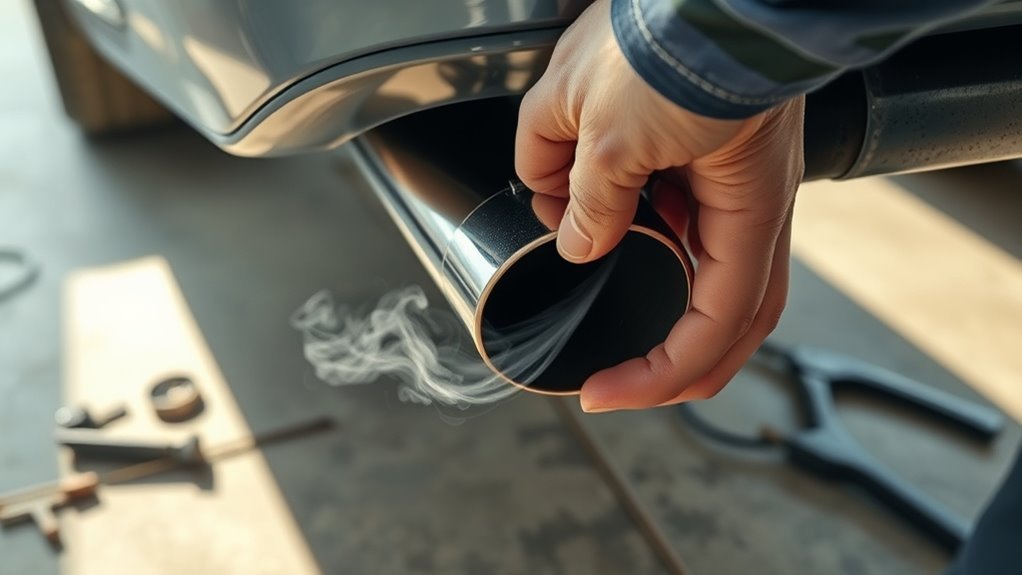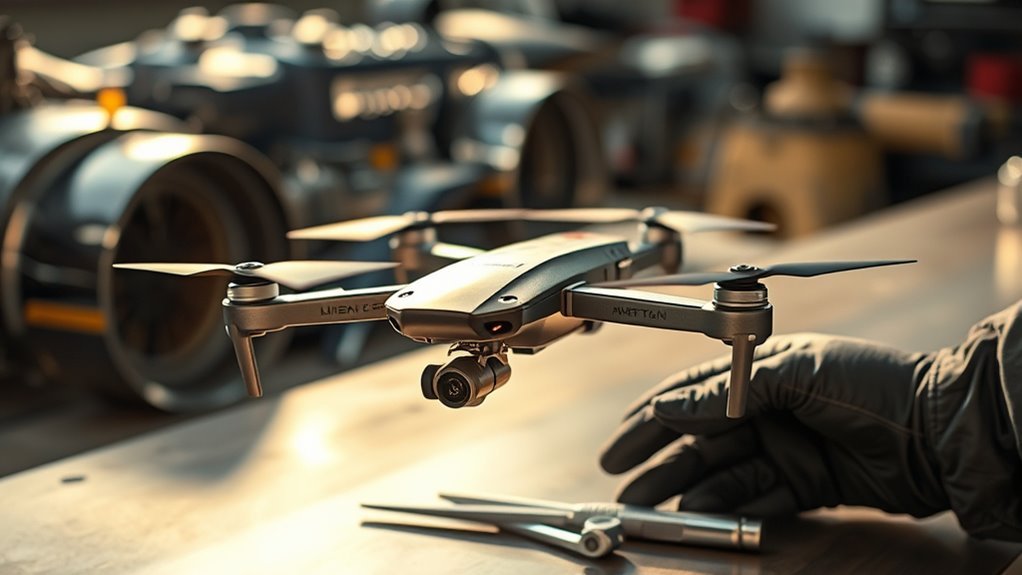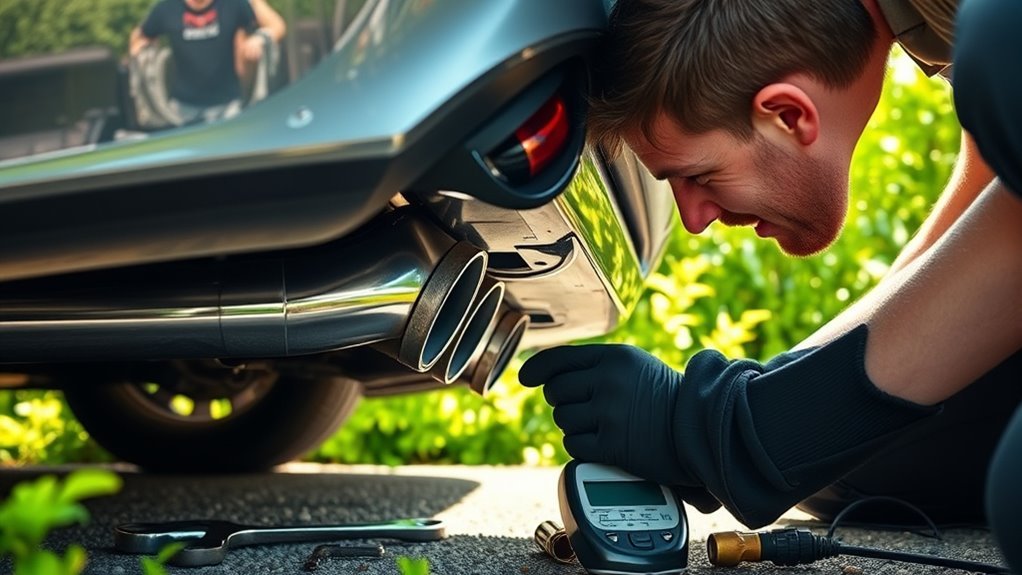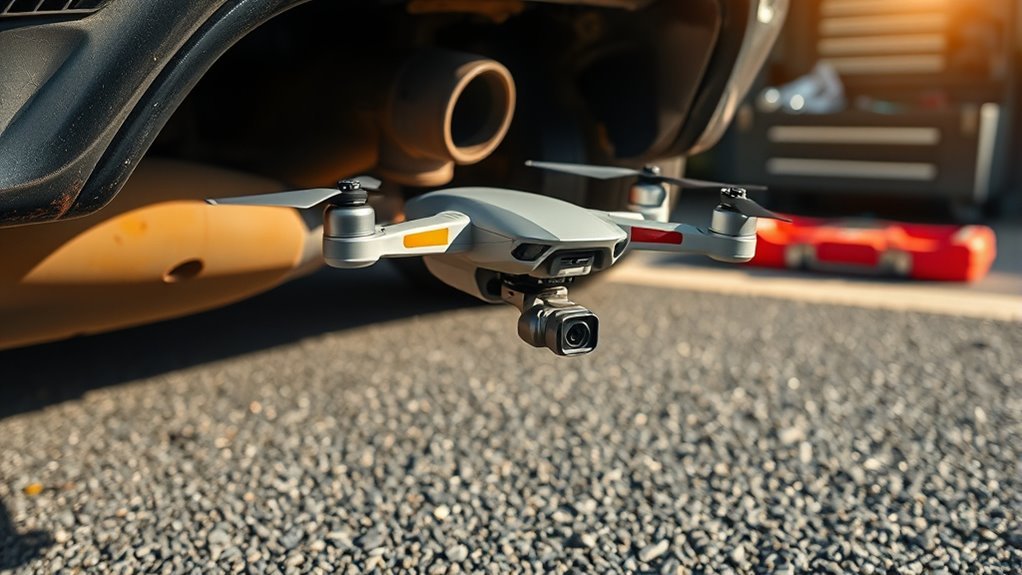You can identify exhaust drone by detecting persistent low-frequency hums at certain RPMs, caused by resonant pressure waves in your exhaust system’s geometry and muffler design. To fix it, start by tightening clamps, adding insulation, or using high-quality sound dampening wraps. Upgrading mufflers and installing resonators matched to specific frequencies also disrupt drone. If drone persists, professional assessment may be needed for tailored solutions. Exploring these steps will equip you to resolve exhaust drone effectively.
What Causes Exhaust Drone in Vehicles

Although exhaust drone might seem like a minor annoyance, it’s caused by specific acoustic frequencies generated within your vehicle’s exhaust system. When exhaust flow moves through the pipes, pressure waves reflect and interact, creating resonant frequencies. These resonances amplify certain sound frequencies, producing the persistent, low-frequency hum known as exhaust drone. The geometry of the exhaust components, including pipe length, diameter, and muffler design, directly influences these frequencies. If the exhaust system’s natural frequencies align with engine RPM or road speed, the drone intensifies. Understanding this interplay allows you to address the root cause rather than just masking the noise. By analyzing the exhaust flow and its resulting sound frequency patterns, you gain control over the acoustic environment, restoring your driving freedom without the intrusion of unwanted drone.
Common Symptoms of Exhaust Drone

Anyone experiencing exhaust drone will notice distinct auditory and tactile indicators that differentiate it from normal engine noise. Primarily, you’ll hear a persistent, low-frequency hum or buzzing that aligns with specific engine RPMs, often between 1,500 and 3,000 RPM. This sound frequency is more pronounced and intrusive than typical exhaust sounds, causing discomfort during steady cruising. Alongside the noise, you’ll feel subtle but continuous exhaust vibration transmitted through the cabin—this tactile feedback is a hallmark symptom. The vibration often resonates in the floorboards, pedals, or seats, amplifying driver fatigue and reducing the sense of control. Recognizing these combined symptoms—audible drone at certain sound frequencies coupled with physical exhaust vibration—is essential for diagnosing and ultimately eliminating this irritating phenomenon, allowing you to reclaim an unencumbered driving experience.
How to Diagnose Exhaust Drone Problems

You’ll first need to confirm the presence of exhaust drone by identifying consistent tonal frequencies during specific RPM ranges. Using diagnostic tools like a decibel meter and frequency analyzer can help quantify the issue objectively. Understanding common causes, such as resonant exhaust components or improper muffler design, will guide accurate troubleshooting.
Recognizing Drone Symptoms
When diagnosing exhaust drone problems, it is crucial to identify specific symptoms that distinguish drone from other engine noises. Drone typically manifests as a persistent, low-frequency hum or vibration felt within the cabin, especially at steady cruising speeds. You’ll notice this drone frequency often aligns with engine RPM ranges, creating discomfort and fatigue over time. Accurate sound measurement can help you pinpoint the issue by isolating the dominant frequency causing the drone. Unlike transient noises, drone is steady and tonal, lacking abrupt changes. By focusing on these characteristics—consistent frequency, tonal quality, and resonance inside the vehicle—you can confirm whether the exhaust system is the source. Recognizing these precise symptoms empowers you to target solutions effectively, restoring your driving freedom without persistent auditory irritation.
Tools for Diagnosis
Accurately identifying exhaust drone requires specialized tools to measure and analyze sound frequencies within the vehicle cabin. You’ll rely on diagnostic tools like sound level meters and frequency analyzers to capture precise acoustic data. These devices detect specific frequency ranges where drone occurs, allowing you to isolate problematic tonal noise from ambient sounds. Using smartphone apps with calibrated microphones can also provide preliminary sound measurement, but professional-grade tools yield more reliable results. Additionally, vibration analyzers help correlate sound data with structural resonance, pinpointing the source of drone. By systematically recording and evaluating frequency spectrums at various RPMs, you gain objective insight into the drone’s characteristics. This precise analysis empowers you to implement targeted fixes, preserving your vehicle’s performance and your freedom from intrusive exhaust noise.
Common Drone Causes
Several factors commonly contribute to exhaust drone, each linked to specific mechanical or acoustic characteristics. Understanding these causes helps you pinpoint and resolve drone frequency issues effectively. Consider these primary contributors:
- Exhaust Pipe Geometry – Length and diameter influence resonance, altering drone frequency.
- Muffler Design – Insufficient baffling or poor internal structure reduces exhaust modulation, intensifying drone.
- Engine Speed Range – Specific RPM bands can amplify drone due to harmonic resonance within the exhaust system.
- Exhaust Material and Mounting – Rigid mounts and certain materials transmit vibrations directly, increasing perceived drone.
The Role of Exhaust System Design in Drone
You’ll find that pipe diameter directly influences the exhaust’s resonance characteristics, affecting drone occurrence. Muffler design also plays a critical role by altering sound attenuation and backpressure, which can shift resonance frequencies. Understanding these factors helps you diagnose and adjust the system to minimize unwanted drone effectively.
Pipe Diameter Effects
Although exhaust drone can result from various factors, pipe diameter plays a critical role in shaping the acoustic characteristics of your system. Proper pipe sizing directly influences exhaust gas velocity and pressure waves, affecting drone frequency and intensity. Here’s how diameter impact matters:
- Smaller diameters increase gas velocity, potentially raising drone frequency but reducing volume.
- Larger diameters lower gas velocity, which can amplify low-frequency drone due to pressure wave reflections.
- Mismatched pipe sizing in segments causes turbulence, exacerbating drone.
- Consistent diameter guarantees smoother flow, minimizing resonance and unwanted drone.
Understanding these dynamics allows you to tailor your exhaust system for ideal freedom from drone while maintaining performance. Precision in pipe diameter selection is essential to control drone without sacrificing exhaust efficiency.
Muffler Design Impact
Beyond pipe diameter, the muffler’s design greatly influences exhaust drone by controlling how sound waves are absorbed, reflected, or canceled within the system. When you evaluate muffler materials, note that denser composites or layered metals can enhance sound attenuation by disrupting wave propagation. The internal structure—chambers, baffles, or perforated tubes—directly affects exhaust flow, balancing backpressure with noise control. If the muffler design restricts exhaust flow excessively, it can increase drone by amplifying specific frequencies. Conversely, optimized flow paths reduce turbulent reflections, minimizing drone. To gain freedom from unwanted noise, you need a muffler that harmonizes material properties and internal geometry to dissipate sound energy effectively without compromising performance. This precision in design is critical for eliminating exhaust drone while preserving engine efficiency.
Resonance Frequency Issues
Several factors contribute to resonance frequency issues in exhaust systems, which play an essential role in generating drone. Understanding how your exhaust design influences resonance allows you to mitigate unwanted noise effectively. Resonance analysis helps pinpoint frequencies where pressure waves amplify, causing drone. Frequency tuning adjusts system parameters to shift these frequencies away from common engine speeds. To address resonance frequency issues, focus on:
- Pipe length and diameter – altering these changes natural frequencies.
- Muffler chamber design – impacts wave reflection and absorption.
- Material stiffness – affects vibration transmission and damping.
- Connection points – resonance can build at junctions or bends.
DIY Methods to Reduce Exhaust Drone
When you want to tackle exhaust drone without professional help, understanding the root cause is crucial for effective DIY solutions. Start by applying exhaust insulation materials strategically around the exhaust system to minimize vibration transmission. High-quality sound dampening wraps or mats reduce resonance by absorbing acoustic energy, lowering drone intensity considerably. Additionally, inspecting and tightening exhaust clamps and hangers guarantees components don’t vibrate excessively, which aggravates drone. You can also experiment with adding mass-loaded vinyl barriers near the cabin firewall to further isolate sound waves. These methods offer a balance of technical precision and practical freedom, enabling you to customize noise reduction without costly upgrades. By systematically combining insulation and sound dampening techniques, you can effectively mitigate exhaust drone and regain control over your vehicle’s acoustic environment.
Upgrading Mufflers to Eliminate Drone
If DIY insulation and sound dampening methods haven’t fully resolved your exhaust drone, upgrading your muffler offers a more targeted solution. To optimize muffler effectiveness and achieve a favorable sound comparison, consider these steps:
- Analyze your current muffler’s design—chambered, straight-through, or turbo—to identify drone frequencies.
- Choose a muffler engineered specifically to disrupt drone-inducing sound waves with advanced baffling or perforated tubing.
- Match the muffler’s flow capacity to your engine’s output to avoid power loss while reducing drone.
- Test sound comparison recordings before and after installation to guarantee drone elimination without sacrificing desired exhaust tone.
Using Resonators and Sound Absorbers
Although upgrading mufflers can considerably reduce exhaust drone, incorporating resonators and sound absorbers provides a complementary approach by targeting specific sound frequencies and vibrations. You’ll find various resonator types—chambered, Helmholtz, and absorption—that selectively neutralize resonant frequencies causing drone. By integrating these resonators along the exhaust path, you disrupt standing waves responsible for persistent noise. Additionally, sound insulation materials, like mass-loaded vinyl or specialized foams, attenuate transmitted vibrations further reducing in-cabin drone. When selecting resonators, consider their frequency tuning and physical compatibility with your system for peak results. Combining resonators with sound insulation offers a precise, multi-layered defense against exhaust drone, granting you the freedom to enjoy quieter rides without sacrificing performance. This targeted strategy guarantees you’re not just masking drone but actively eliminating its root causes.
When to Seek Professional Help for Exhaust Drone
How do you determine the right moment to involve a professional in addressing exhaust drone? When self-diagnosis and basic fixes don’t resolve persistent drone, it’s time to seek expert consultation. A professional assessment guarantees precise identification of underlying causes and effective solutions.
Consider professional help if you experience:
- Persistent drone despite installing resonators or sound absorbers
- Structural exhaust damage or corrosion beyond simple repairs
- Complex modifications that affect system dynamics requiring calibration
- Need for compliance with noise regulations or performance standards
Engaging a professional grants you freedom from guesswork and assures a tailored resolution. Don’t hesitate to leverage expert consultation to reclaim ideal acoustic performance and driving satisfaction.

